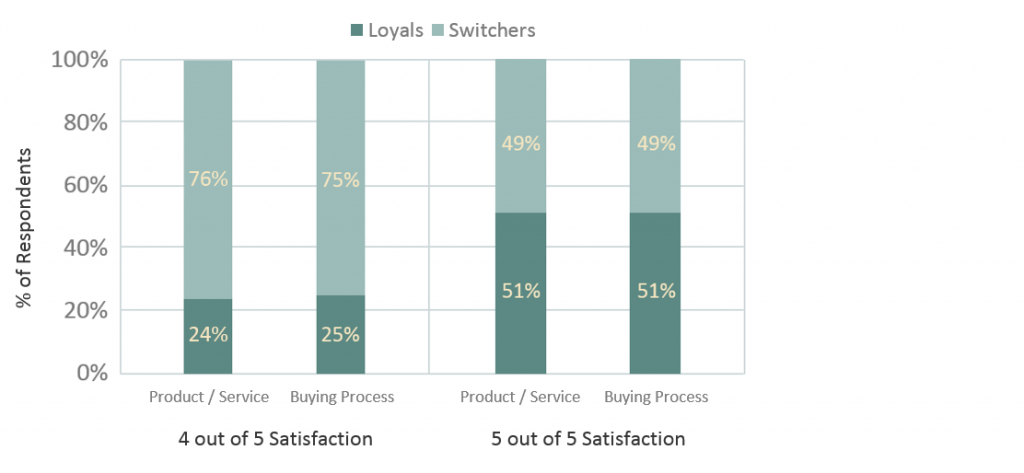First Impressions Last the Longest: The Final Installment in the Client Service Series
In this final part of my blog series on client service, let’s talk about loyalty. Everyone knows that loyalty is the ultimate driver of long-term success for any enterprise, and this is particularly true for those selling intangibles – like banks, software companies and advisory firms. Loyalty is a critical metric for any business, measuring not only how committed a customer is to your business, product or brand, but also indicating the potential lifetime value of that customer and the likelihood of her or him bringing more customers to you.
What’s interesting is that most firms – and research – measure loyalty and satisfaction only after the sale is made. This is wrong. The foundation for loyalty is actually set well before the sale closes. It certainly becomes more established in the sales process, though in time I believe it will be proven that the client’s first experience with a brand – whether that experience is a person or a digital touchpoint – will be the most important.
With the bar for success being continuously raised, firms need to go deeper and start earlier in the relationship than ever before to remain competitive. RAIN Group research shows a strong correlation between pre-sales satisfaction and long-term loyalty. In fact, according to RAIN’s Mike Schultz, “Loyalty doesn’t only come from the buyer’s satisfaction with your product or service. Satisfaction before they buy is just as important.”

RAIN Group’s research suggests that “the buyer’s experience in the buying process is just as predictive of ongoing loyalty as product or service satisfaction”. Source: The RAIN Group Center for Sales Research
The first brand experience: the birth of customer satisfaction
I certainly agree with RAIN’s conclusions, but believe future research will show that client satisfaction and loyalty starts with the very first experience with a brand – regardless of channel. The brand promise needs to be clear and consistent from the CEO through every employee, as well as every channel, digital or physical – from the office space to web properties, advertisements, newsletters, re-sellers, UIs, apps, you name it.
When even one of these factors is “off” in the mind of the buyer, client satisfaction and loyalty suffer. Truly great companies take considerable care of the so-called softer things. They carefully define the firm’s vision, mission, values, goals, and objectives. They know what problems they solve and who their clients are before they sell them anything. They align their operations to optimize their value and they invest in ensuring that their corporate message – or brand promise – is strong, relevant and omnipresent.
Brand loyalty by the numbers
Some leaders find it difficult to invest precious time and money into intangibles like client perception studies, company messaging, thought-leadership, PR and the like. Without a concrete correlation between these activities and short-term ROI, many stick to what they believe works – which are ineffective and irritating tactics that promote a muddled message and inconsistent or unclear value propositions.
In the meantime, the data continues to pile up and our ability to analyze this data grows (#bigdata / IoT anyone?). Top companies build great brand loyalty by excelling at both measuring and reacting to this data and delivering on the softer things, like messaging and service. As a result, they build abundant loyalty.
These leading companies understand a simple fact: Investing in brand is not optional; it’s table stakes if you want to compete.
NOTE: This blog series explores the shifting customer service model and client loyalty. Links and summaries of the first two installments are below.
Part 1 of the series, Exceptional Service from Amtrak. Wait. What??, explored what differentiates truly exceptional service from middling, run-of-the-mill service. The answer is remarkably simple: exceptional service is defined by surprising the client by exceeding his or her expectations.
Part 2, Do Your Job, discussed why it is so difficult to exceed client expectations nowadays and how today’s contract negotiations often lead to impossibly high hurdles for success. Over-promising salespeople as well as unrealistic buyers and everything in between creates these hurdles. This is also the source of common mistakes by service-providers including working hard on the wrong things or, worse, deluding themselves with justifications and excuses.
What first impression is your brand making?
What do you think? Share your experiences and results with the first impressions your brand has created – or even how your own first encounter with any brand influenced your satisfaction – in the Comments box below.
This post was written for Paragon by Mike Ross.




Leave a comment:
You must be logged in to post a comment.